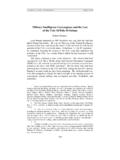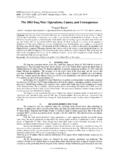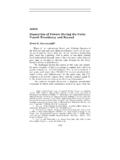Transcription of CONSOLIDATED FATF STRATEGY ON …
1 fatf , 19 February 2016 CONSOLIDATED fatf STRATEGY ON combatting TERRORIST financing I. INTRODUCTION 1. In 2014, the fatf agreed an overall AML/CFT STRATEGY , which set out the challenges and the priorities that faced the fatf for period 2014-16, and set out how the fatf planned to achieve its objectives. combatting terrorist financing has been a priority for the fatf since 2001, however, in 2015, the scope and nature of terrorist threats globally intensified considerably, with terrorist attacks in many cities across the world, and the terrorist threat posed by the so-called Islamic State of Iraq and the Levant (ISIL/Da esh), and by Al-Qaeda and their affiliated terrorist organisations, and by other terrorist organisations also becoming more significant. In December 2015, the fatf agreed that further concerted action urgently needs to be taken to strengthen global counter-terrorist financing regimes to combat the financing of these serious terrorist threats, and contribute to strengthening the financial and economic system, and security.
2 2. A range of areas were identified where more work needs to be done and the international community needs to take stronger and more effective action, in particular by enhancing co-operation and co-ordination, both domestically and internationally. This CONSOLIDATED fatf STRATEGY paper lays out comprehensively but concisely: the framework, mechanisms and actions that are already in place; the current threats that are faced; and the key policy objectives and the priority actions the fatf and the global network will take in this fight against terrorism and terrorist financing . II. EXISTING fatf ACTIONS TO COMBAT TERRORIST financing 3. combatting and disrupting terrorist financing creates a hostile environment for terrorism. Lack of money limits the capability of terrorist groups to prepare or carry out attacks; and financial intelligence can reveal the structure of terrorist groups, the activities of individual terrorists , and their logistics and facilitation networks.
3 financing is important for all terrorists - from large terrorist organisations which control territory to small terrorist cells. 4. The fatf has put in place a global framework of standards since 2001 to combat the financing of terrorism, complementing the UN Security Council Resolutions. The fatf Recommendations set out a comprehensive and consistent framework of measures which countries should implement in order to effectively combat money laundering and terrorist financing , while still implementing national measures adapted to their particular circumstances. The Recommendations provide a complete legal and institutional framework that gives jurisdictions the tools needed to combat TF, including requirements to: identify, assess and understand TF risks ( ); comprehensively criminalise TF as a distinct offence ( ); CONSOLIDATED fatf STRATEGY ON combatting TERRORIST financing 2 have targeted financial sanctions and terrorist asset freezing ( ); equip law enforcement agencies and financial intelligence units (FIUs) with all necessary powers and resources ( ); detect and prevent illicit cross-border transportation of cash ( ); ensure prompt and constructive international and domestic cooperation ( , ); and take preventive measures to protect sectors that could be misused (financial, non-financial, non-profit organisations (NPOs)) ( ).
4 5. To help jurisdictions implement the standards, the fatf has also issued Guidance and Best practices papers, including on the implementation of targeted financial sanctions, the abuse of NPOs, detecting terrorist financing and other issues related to combating terrorist financing . A robust assessment Methodology is used in a comprehensive peer review and follow-up process applied by fatf and all fatf -Style Regional Bodies (FSRBs), and this helps to ensure not only technical compliance with the standards, but also their effective practical implementation. The International Cooperation Review Group (ICRG) process helps to apply additional pressure on jurisdictions that are not making enough progress. 6. Considerable work has been done to assist jurisdictions in identifying and understanding the TF threats and vulnerabilities on both global and regional scales.
5 The fatf has published nearly a dozen reports on general TF methods in the period between 2008 and 2015, as well as dedicated studies on individual terrorist organisations such as Al-Qaeda and associated groups in Western Africa (2013), Taliban in Afghanistan (2014), and Islamic State in Iraq and the Levant (2015). The fatf also works to keep abreast of current developments in this field, and published a report on Emerging Terrorist financing Risks in late 2015. The fatf reports usually contain specific red flag indicators to help financial institutions identify suspicious activity and report it to the authorities. 7. Additionally, in 2015 the fatf conducted an urgent Fact Finding Initiative in more than 190 jurisdictions which identified jurisdictions which do not have adequate legal frameworks for implementing key elements of Recommendations 5 and 6.
6 A few jurisdictions lack legal powers to prosecute terrorist financiers or to apply targeted financial sanctions, while others have significant gaps or weaknesses in their measures to combat TF. This initiative is ongoing, but 36 jurisdictions - including 40% of the countries that lacked legal powers - have already taken remedial action. 8. The fatf has also now started a number of other initiatives, including a global process to assess TF risks; a process to address the issues that jurisdictions are facing in accessing and sharing information; and further work on the fatf Standards relating to NPOs. 9. Under its mandate, the fatf is not only the international standard setter, but also monitors and oversees effective implementation of those standards at the national level, and takes a lead role and co-ordinates actions with many partner organisations, such as the FSRBs, the Egmont Group of Financial Intelligence Units, relevant UN bodies and committees, and the IMF and World Bank.
7 At a national level, fatf and FSRB members ensure that they take comprehensive and effective action to combat terrorist financing . CONSOLIDATED fatf STRATEGY ON combatting TERRORIST financing 3 10. However the threat from terrorism and its financing is always changing. This CONSOLIDATED safestrategy sets out how the fatf will increase the relevance and effectiveness of the tools used to combat terrorist financing , to address the threat. III. CURRENT TERRORIST/TERRORIST financing THREATS 11. Large terrorist organisations, particularly ISIL/Da esh, as well as foreign terrorist fighters and small terrorist cells pose significant threats to members and the international community as a whole. Terrorist groups such as ISIL/Da esh and Al Qaida have developed links to many different countries by supporting rebels or extremists to organise themselves or as a result of existing terrorist groups pledging their allegiance to them.
8 Groups such as Boko Haram or ISIL/Da esh in Libya have sought ISIL/Da esh affiliation in order to gain notoriety, financial support and to attract recruits. These affiliates also attract foreign terrorist fighters from around the world as well as inspiring small terrorist cells or individual terrorists to commit acts of terror in countries all over the world, and establishing facilitation networks. The different terrorist financing risks associated with each of these threats are set out below. TERRORIST ORGANISATIONS WHICH CONTROL TERRITORY 12. Terrorist organisations such as ISIL/Da esh, which control territory or conduct military-like operations require significant funds to maintain their infrastructure, personnel, and activities and a large stable income to support their operations.
9 ISIL/Da esh s finances are highly centralised, with a governing body controlling all revenues and expenses. ISIL/Da esh s STRATEGY has been to rely on funds generated within the territory it controls including the sale of oil and extortion from individuals and businesses. This income is supplement by the proceeds of smuggling of cultural artefacts, sale of gas and other natural resources, bank looting and robbery, kidnapping for ransom and donations. In response to actions to stop it from exploiting the formal financial sector, ISIL/Da esh to a certain extent has had to rely on money remitters and money exchangers to move money within its territory and across the region. There are concerns about whether this allows ISIL/Da esh to transfer funds internationally.
10 13. ISIL/Da esh s influence and presence has also expanded globally with recognised affiliates in North and West Africa (including Boko Haram), Pakistan and Afghanistan and the Arabian Peninsula. It is likely that some of these groups have pledged allegiance to ISIL/Da esh for financing purposes. These developments may see an increase in the movement of funds to or from ISIL/Da esh or through affiliates that act as regional hubs to transfer funds. FOREIGN TERRORIST FIGHTERS (FTFS) 14. The issue of FTFs is not a new phenomenon, but the recent scale of the issue in relation to the conflict in Syria and Iraq, as well as the role they have played in recent terrorist attacks around the world are disturbing. While FTFs are not presently considered to be a significant source of funding for ISIL/Da esh or Al-Nusrah Front (ANF), they contribute to the larger TF threat posed by these groups.
















